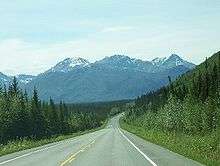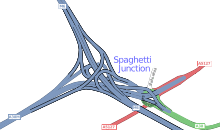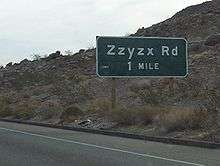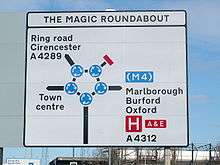Roadgeek


A roadgeek (from road + geek) is an individual involved in "roadgeeking" or "road enthusiasm"—an interest in roads, and especially going on road trips, as a hobby. A person with such an interest is also referred to as a road enthusiast, road buff, roadfan or Roads Scholar, the latter being a play on the term Rhodes Scholar.[1]
Interest
Roadgeeks view their interest as an appreciation of engineering and planning feats:
| “ | We're interested in all the effort that goes into making roads. The railways in this country get an awful lot of press as great engineering achievements. Roads aren't seen in that way, but it wasn't always so. In the 1950s and 1960s they were part of a brave new era. Back then it was something to get excited about. They actually put people on buses and drove up and down them to have a look... | ” | |
| — Steven Jukes[2] | |||


However roadgeeks are not necessarily interested in motor vehicles;[2] there may also be an interest in cartography and map design. Enthusiasts may focus on a single activity related to roads, such as driving the full length of the highway system in a specific area, researching the history, planning and quirks of a particular road or national highway system. They occasionally are quoted in the press on topics related to the history of roads.[3] Sometimes, road geeks are called "highway historians" for the knowledge and interests.[4]
Even the numbering system can be a subject of deep interest, as Joe Moran describes in his book "On Roads: A Hidden History":
| “ | On the online discussion forum of SABRE, the Society for All British Road Enthusiasts" (sic), the 1400-odd Sabristi often debate about where the M25 starts and whether it is correctly numbered, or why the motorway from Carlisle to Glasgow is called both the M74 and the A74(M). In road-numbering lore, the absence of pattern—the discovery that there are so many exceptions to rules that the rules might as well not exists—only seems to revivify the search for inner mysteries. Road buffs talk in reverential tones about "David Craig Numbers" - the elegant theory, named after the man who proposed it, that three digit numbers derive from the roads they connect.[5] | ” |
Activity
Example activities include:
- Creating fonts and other graphic elements to share with other enthusiasts[6]
- Taking road trips for the roads rather than for the destination, sometimes referred to as roadgeeking or Roads Scholaring
- Comparing the extent of their travels with other enthusiasts, such as the number of Interstate Highway sections that have been wholly traveled.[7]
- Photography of road signs, bridges or various highway artifacts
- Collecting old road maps
- Writing about the history of highways,[8] highway terminology and the design of graphics or fonts to facilitate the work of others.
Online
In 2002, the St. Louis Post-Dispatch reported that road enthusiasm was an Internet phenomenon. There is a Usenet newsgroup, misc.transport.road, where participants discuss all facets of roads and road trips from "construction projects to quirks and inconsistencies in signage".[9] These individuals who anticipated each Rand McNally road atlas release each year found a community of others online who were also interested in roads as a hobby. These communities of people could share photos, swap their thoughts on the highways in their areas and "debate the finer points of interchange design."[9]
Yahoo Groups and Forums
There are several Yahoo Groups dedicated to Roadgeek activities, including the "Roadgeek YahooGroup". group itself and many regional or special interest groups.
Web based forums are also popular, the largest is "AARoads Forum"..
SABRE
Started in 1999, the Society for All British and Irish Road Enthusiasts (SABRE), originally known as "Study and Appreciation of the British Roads Experience",[10] is one of the larger and most prominent communities of road enthusiasts online.[11] The organization hosts a large collection of articles and histories of particular roads and terminology, online photo galleries, discussion forums,[12] and an application to overlay and compare historical roadmaps.[10] Although SABRE is primarily an online group, members organize group tours to visit sites of interest.[2]
Taiwan websites
In 2006, a board called "Road" (Chinese: 公路板) in the PTT Bulletin Board System, which is a Taiwanese forum, was established.[13] Because some Taiwanese road enthusiasts didn't know how to use a terminal or BBS reader to access it, the web forum Taiwan Highway Club (Chinese: 公路邦; literally, "Highway State") was started in 2008;[14] it contains subforums allowing users to discuss road policies, and to add news about, and post pictures of, highways.[15] However, since the online community service by Pixnet was discontinued in 2012, the site moved to http://www.twroad.org/.
Partial list of roadgeek topics

Brazil
- BR-485, providing access to the interior of Itatiaia National Park, is the highest highway in the country. The highway's highest point is at kilometer post 36 (22 mi) (with the count starting in the city of Itatiaia), beyond the third entrance to the park (called Posto Avançado das Agulhas Negras), just northeast of the Eletrobras Furnas radio broadcasting station.
- BR-488, in Aparecida, São Paulo, is the shortest federal highway in the country, at 5.9 kilometers (3.7 mi).[16]
- BR-116, the longest highway in the country.
- Trans-Amazonian Highway (BR-230), the longest highway that crosses the Amazon Rainforest.
- The Belém-Brasília Highway has many decommissioned stretches along its route.
- BR-363 is the only highway in the country that is located on an oceanic island, Fernando de Noronha.
Canada
- The Coquihalla Highway is an engineering marvel.
Republic of Ireland
- The Mad Cow Roundabout located at junction 9 on the M50 was notoriously congested and locally known as the Mad Cow roundabout instead of its actual name the Red Cow interchange.[17]
United Kingdom
- The Magic Roundabout in Swindon consists of five mini-roundabouts arranged in a circle.[11]
- Gravelly Hill Interchange, one of many known as Spaghetti Junction, is junction 6 of the M6 motorway where it meets the A38(M) Aston Expressway in Birmingham.[11]
- The A64(M) portion of Leeds Inner Ring Road is classified as a "pathetic motorway" by one SABRE member because it is "sadly, only 800 yards long and that's if you go the long way."[2]
- The expansive but unrealised London Ringways system.
United States
Arizona
- Interstate 15 only traverses 30 miles through the northwest corner of the state, but is considered one of the most scenic interstate routes as it winds through the Virgin River Gorge.
- Interstate 19 is signed in metric units.
Arkansas
- Arkansas Highway 43/Oklahoma State Highway 20 concurrency, the only concurrency of two state highways from different states.[18]
California

- The Ridge Route, the first paved highway directly linking the Los Angeles Basin with the San Joaquin Valley over the Tejon Pass, a portion of which is in the National Register of Historic Places. It was documented by author and roadgeek, Harrison Irving Scott, in 2002, in Ridge Route: The Road That United California.[19]
- State Route 35 (Skyline Boulevard), the road that spans the highest ridge of Santa Cruz Mountains, making it possible to see the Pacific Ocean and San Francisco Bay simultaneously.
- Decommissioned portions of U.S. Route 6, now part of State Route 14, are the subject of significant roadgeek interest.[20]
- Zzyzx Road, a landmark about halfway between Los Angeles and Las Vegas, known for its unusual name. It is the last place on Earth in the English language alphabetically.
- Interstate 238 in the San Francisco Bay Area which defies numbering logic both by location and the absence of its parent, Interstate 38.
- The portion where Interstate 580 and Interstate 80 run concurrently (through Berkeley), which happens to be a wrong-way concurrency. This means that one road goes east and the other goes west at the same time.
Colorado
- Interstate 70's route through Glenwood Canyon, an engineering marvel.
- Eisenhower Tunnel, the highest point on the Interstate Highway System.
Delaware
- Delaware Route 1 was originally signed in metric units.
- Delaware Route 1 replaces the old US Route 13.
Maryland
- A portion of Route 54 running directly on the state line (almost directly on the double yellow line) is signed as Maryland Route 54 eastbound only while the westbound lane lie in Delaware and is signed as Delaware Route 54.
- I-70's eastern terminus at a Park & Ride on MD 122 (Security Boulevard) in Baltimore, one of the more unusual Interstate termini.
- Interstate 97, the shortest two-digit Interstate Highway in the US existing entirely within Anne Arundel County.
Missouri
- Galena Y-Bridge, an unusual bridge with three land connections.
Montana
- Going-to-the-Sun Road, a scenic road crossing Glacier National Park, designated both a National Historic Landmark and a Historic Civil Engineering Landmark.[21]
New Jersey
- NJ 495 travels through a helix on approach to the Lincoln Tunnel providing an uninterrupted view of the Manhattan, New York skyline.
- I-95 parallels itself as it exists in two unconnected sections. This will be corrected in 2018 when an interchange between I-95 and the Pennsylvania Turnpike is opened, allowing I-95 to be rerouted onto both state's turnpikes.
New York
- Interstate 990, the highest numbered interstate in the system.
- Interstate 878, the shortest interstate in the system.
- New York State Route 17 enters Sayre, Pennsylvania, briefly to curve around Waverly, New York. The road is maintained by NYSDOT but is patrolled by the Pennsylvania State Police. A PennDOT-constructed bridge crosses the New York-designed and -maintained road in this stretch.
- A similar situation also exists where I-684 crosses into Greenwich, Connecticut, for a few miles, but is maintained by NYSDOT.
North Carolina
- Interstate 73, which lies east of Interstate 77.
Ohio
- The Interstate 271/Interstate 480 concurrency in Cleveland is the only instance of two auxiliary (3-digit) interstate highways sharing pavement in the system.
Oklahoma
- Arkansas Highway 43/Oklahoma State Highway 20 concurrency, possibly unique instance of two highways from different states overlapping.
Oregon
- Historic Columbia River Highway, the first paved highway in the Pacific Northwest, an engineering and scenic marvel, designated both a National Historic Landmark and a Historic Civil Engineering Landmark.[22]
Pennsylvania
- Abandoned Pennsylvania Turnpike, an example of 1930s'-era highway standards.
- Breezewood, Pennsylvania, a gap in I-70 that routes traffic down US 30 through town. A similar situation exists with I-676 using portions of 6th Street eastbound and Vine Street westbound to access the Ben Franklin Bridge in Philadelphia.
- Centralia, Pennsylvania, site of underground coal fires undermining the area highways.
- Interstate 99, which lies west of several lower-numbered interstates, such as Interstate 81 and Interstate 95.
- Interstate 476 is the longest auxiliary interstate in the system and ends abruptly at a sharp curve near Clarks Summit, ending just a few hundred yards from Interstate 81. This is because the Pennsylvania Turnpike's Northeast Extension was to continue north towards New York but was later constructed as I-81. Current plans call for the completion of this connection starting in 2020.
Virginia
- The Wrong-way concurrency of Interstate 77 and Interstate 81, where one goes north on one route and south on the other at the same time. Located near Wytheville. The road is oriented east–west in this overlap.[23]
- The Chesapeake Bay Bridge–Tunnel, a 23-mile-long (37 km) fixed link crossing the mouth of the Chesapeake Bay. Selected by the American Society of Civil Engineers (ASCE) as "One of the Seven Engineering Wonders of the Modern World".
Washington
- Interstate 82, which is not only completely north of Interstate 84, but also runs predominantly north–south, despite its even number.
Other
- U.S. Route 66, an iconic highway across the western USA whose remnants attracts enthusiasts from around the globe. There are several Route 66 museums and attractions along the road.
- List of gaps in Interstate Highways
Relationship with governments
In Taiwan, the Ministry of Transportation and Communications' Directorate General of Highways (公路總局) has held occasional Road Fan Conferences (公路迷座談會) since 2011 to allow roadfans and highway transportation-related organizations to make suggestions to the government.[24]
Roadgeek websites (partial)
- Brad's Australian Highways Page; founded September 19, 1999
- CBRD (Chris's British Road Directory)
- Glasgow's Motorways Fan & Info Site
- Great Lakes Roads Yahoo! Group (US); founded February 16, 2002
- Irish Roads forum on boards.ie
- The King's Highway (Ontario, Canada highways)
- Kurumi's Field Guide to Interchanges
- misc.transport.road (Usenet); charter approved November 27, 1995[25]
- misc.transport.road FAQ
- Northern Ireland Road Site
- Ozroads: The Australian Roads Website; founded July 13, 2003
- Pathetic Motorways (UK)
- Roadgeek Yahoo! Group; founded April 25, 1999
- Roads UK
- Society for All British and Irish Road Enthusiasts (SABRE), founded August 13, 1999
See also
- County collecting
- Metrophile
- OpenStreetMap
- Railfan
- Spotting
References
- ↑ Wear, Ben (December 12, 2004). "Road to Future or a Dead End". Austin American-Statesman. Archived from the original on September 5, 2006. Retrieved January 20, 2007.
- 1 2 3 4 Gupta, Lila Das (January 17, 2005). "Never Mind the Trainspotters". The Daily Telegraph. London. Retrieved April 9, 2009.
- ↑ Gordon, Sarah (November 2, 2009). "M1 and Watford Gap Celebrate 50 Years...with a 6p Cup of Tea". The Daily Mail. London. Retrieved June 21, 2011.
- ↑ Miller, Matthew (February 22, 2009). "Looking Back: I-496 Construction, a Complicated Legacy". Lansing State Journal. pp. 1A, 8A.
- ↑ Moran, Joe (2009). On Roads: A Hidden History (Hardcover ed.). London: Profile Books. p. 77. ISBN 1-84668-052-2.
- ↑ "Roadgeek Fonts". Michael Adams' Blog. Retrieved December 19, 2014.
- ↑ "My Clinched Freeways". Mike the Actuary's Musings. Archived from the original on August 21, 2008. Retrieved November 16, 2007.
- ↑ Kelly, John (February 21, 2005). "A Long Way to Go for a Refund". Washington Post. p. C11. Retrieved June 27, 2008.
- 1 2 Lamb, William (September 22, 2002). "'Road Geeks' Ramp Up Their Hobby on the Information Superhighway". St. Louis Post-Dispatch. p. C1. Retrieved July 20, 2008. (subscription required)
- 1 2 "Society: About Us". Society for All British Road Enthusiasts. Retrieved June 21, 2011.
- 1 2 3 Milmo, Cahal (October 29, 2004). "Round the Bend? How We Became a Nation of Roadies". The Independent. London. Retrieved April 9, 2009.
- ↑ Greenacre, Simon (September 10, 2008). "Society for All British Road Enthusiasts". Total Vauxhall. Gloucester: A & S Publishing. ISSN 1474-1393. Retrieved June 14, 2011.
- ↑ 公告 公路板開了~ (in Chinese). Road board of PTT Bulletin Board System. Retrieved September 30, 2011.
- ↑ 【公路邦】成立 (in Chinese). Road board of PTT Bulletin Board System. Retrieved September 30, 2011.(Taiwanese Mandarin)
- ↑ "公路邦 > 討論區首頁". 公路邦. Retrieved September 30, 2011.
- ↑ "Lei nº 11.314, de 3 de Julho de 2006" (in Portuguese).
- ↑ Bielenberg, Kim (January 19, 2008). "My Mad Cow Break (Wish You Were Here)". Independent.ie. Independent News & Media. Retrieved April 9, 2009.
- ↑ McMahon, Martin. "Oklahoma Terminus: Arkansas SH-43". Roadklahoma. Archived from the original on September 30, 2007. Retrieved July 17, 2008.
- ↑ Scott, Harrison Irving (2002). Ridge Route: The Road that United California. Torrence, California: H.I. Scott. ISBN 978-0-615-12000-3.
- ↑ Leff, Lisa (May 14, 2002). "Behind the Wheel: Road Scholars Driven to Go the Extra Mile; A Small but Dedicated Band of Buffs Spends Free Time Studying and, Yes, Traveling the State's Highways and Byways". Los Angeles Times. p. B2. Retrieved June 27, 2008. (subscription required)
- ↑ Staff (May 31, 2011). "Going-to-the-Sun Road Information and Transit System". National Park Service. Retrieved June 21, 2011.
- ↑ "Historic Columbia River Highway". Retrieved June 21, 2011.
- ↑ Google (March 16, 2012). "Wytheville" (Map). Google Maps. Google. Retrieved March 16, 2012.
- ↑ "官民合作‧大道開闊 公路總局舉辦第二次公路迷座談會".
- ↑ Herron, Kenneth (November 27, 1995). "RFD unmoderated group misc.transport.misc" (TXT). Internet FAQ Archives. Advameg. Retrieved August 16, 2009.
Further reading
- Beresford, Kevin (2004). Roundabouts of Great Britain (Hardcover ed.). London: New Holland. ISBN 978-1-84330-854-6.

